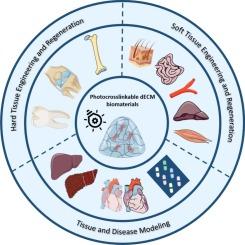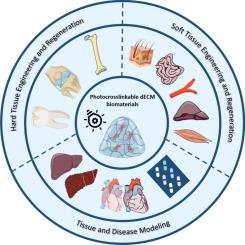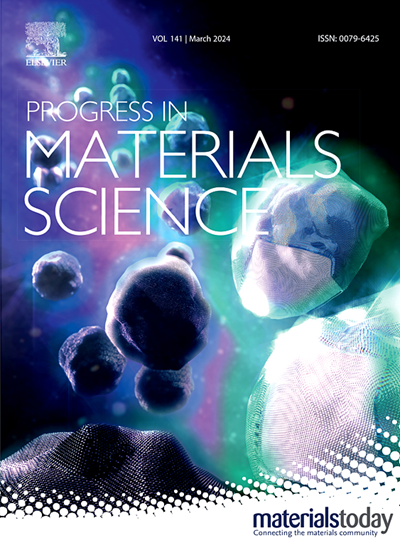光活化脱细胞细胞外基质生物材料:进展、应用及临床前景
IF 40
1区 材料科学
Q1 MATERIALS SCIENCE, MULTIDISCIPLINARY
引用次数: 0
摘要
脱细胞细胞外基质(dECM)生物材料和水凝胶由于其内在的组织特异性生化线索,在损伤或病变组织/器官的组织发育和再生中引起了特别的关注。然而,这些生物材料在机械强度、结构稳定性、快速降解和难以处理方面面临着严峻的挑战。这些缺点确实削弱了它们作为组织替代品的治疗功能。用光响应剂修饰dECM生物材料,使其在紫外线或可见光照射下建立共价交联。本文综述了光交联技术和方法在decm中的应用现状及其作用机制。本文还阐述了光活化的dECM生物材料在软硬组织工程和再生、植入式生物假体、转化医学、疾病或肿瘤建模以及药物筛选平台等方面的应用。此外,还介绍了用于3D生物打印支架和组织工程构建物(tec)的光交联dECM生物墨水的可加工性的最新进展,重点介绍了它们的生物功能。最后,阐述了光活化dECM生物材料目前面临的挑战和解决这些问题的潜在解决方案,并为转化医学铺平了道路。该综述得出结论,光活化的dECM生物材料的适用性作为患者特定的医疗保健解决方案具有很大的前景。本文章由计算机程序翻译,如有差异,请以英文原文为准。


Light-activated decellularized extracellular matrix biomaterials: Advances, applications, and clinical prospects
Decellularized extracellular matrix (dECM) biomaterials and hydrogels have drawn particular attention for tissue development and regeneration of injured or diseased tissues/organs owing to their intrinsic tissue-specific biochemical cues. However, these biomaterials face serious challenges regarding their mechanical strength, structural stability, fast degradation, and difficult handling. These shortcomings indeed alleviate their therapeutic functions as tissue substitutes. Modifying dECM biomaterials with light-responsive agents enables them to establish covalent crosslinks upon UV or visible light exposure. This review aims to elaborate on the current status of photocrosslinking techniques and methodologies applied for dECMs and the underlying mechanisms of action. Herein, we also elucidate the application of light-activated dECM biomaterials in the engineering and regeneration of soft and hard tissues, implantable bioprostheses, translational medicine, disease or tumor modeling, and drug screening platforms. Moreover, the recent advances in the processability of photocrosslinked dECM bioinks for 3D bioprinting scaffolds and tissue-engineered constructs (TECs) with a focus on their bio-functionality are covered. Finally, the current challenges of light-activated dECM biomaterials and potential solutions to address these issues and pave the way for translational medicine are elaborated. The review concludes that the applicability of the light-activated dECM biomaterials holds great promise as a patient-specific healthcare solution.
求助全文
通过发布文献求助,成功后即可免费获取论文全文。
去求助
来源期刊

Progress in Materials Science
工程技术-材料科学:综合
CiteScore
59.60
自引率
0.80%
发文量
101
审稿时长
11.4 months
期刊介绍:
Progress in Materials Science is a journal that publishes authoritative and critical reviews of recent advances in the science of materials. The focus of the journal is on the fundamental aspects of materials science, particularly those concerning microstructure and nanostructure and their relationship to properties. Emphasis is also placed on the thermodynamics, kinetics, mechanisms, and modeling of processes within materials, as well as the understanding of material properties in engineering and other applications.
The journal welcomes reviews from authors who are active leaders in the field of materials science and have a strong scientific track record. Materials of interest include metallic, ceramic, polymeric, biological, medical, and composite materials in all forms.
Manuscripts submitted to Progress in Materials Science are generally longer than those found in other research journals. While the focus is on invited reviews, interested authors may submit a proposal for consideration. Non-invited manuscripts are required to be preceded by the submission of a proposal. Authors publishing in Progress in Materials Science have the option to publish their research via subscription or open access. Open access publication requires the author or research funder to meet a publication fee (APC).
Abstracting and indexing services for Progress in Materials Science include Current Contents, Science Citation Index Expanded, Materials Science Citation Index, Chemical Abstracts, Engineering Index, INSPEC, and Scopus.
 求助内容:
求助内容: 应助结果提醒方式:
应助结果提醒方式:


